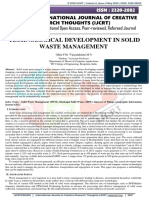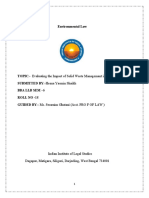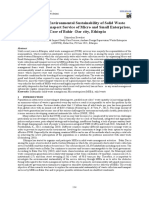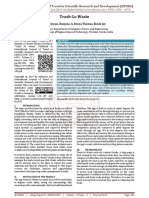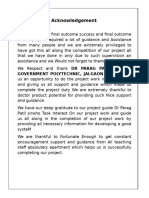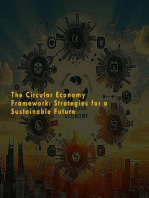137 Waste NC
137 Waste NC
Uploaded by
aniketsharma1800Copyright:
Available Formats
137 Waste NC
137 Waste NC
Uploaded by
aniketsharma1800Original Title
Copyright
Available Formats
Share this document
Did you find this document useful?
Is this content inappropriate?
Copyright:
Available Formats
137 Waste NC
137 Waste NC
Uploaded by
aniketsharma1800Copyright:
Available Formats
Volume 12, Issue 5, May 2023
Impact Factor: 8.423
International Journal of Innovative Research in Science, Engineering and Technology (IJIRSET)
|e-ISSN: 2319-8753, p-ISSN: 2347-6710| www.ijirset.com | Impact Factor: 8.423| A Monthly Peer Reviewed & Referred Journal |
|| Volume 12, Issue 5, May 2023 ||
| DOI:10.15680/IJIRSET.2023.1205137 |
Waste Treatment Techniques for Utilization
in Various Cities of India
Abhishek Gupta1, Abdul Rauf2, Abhishek3 , Aniket Sharma4, Harsh Mittal5, Manish Kumar6,
Sumit Saini7
B.Tech Student, Department of Civil Engineering, Jaipur Engineering College & Research Centre, Jaipur, India 1-6
Assistant Professor, Department of Civil Engineering, Jaipur Engineering College & Research Centre, Jaipur, India 7
ABSTRACT: India is facing a significant challenge in managing its increasing urban waste, which is a result of the
country's growing population and urbanization. Traditional waste disposal methods, such as open dumping and
burning, have negative impacts on public health and the environment. To address this issue, various waste treatment
techniques have been implemented in different cities across India. This study aims to provide a comprehensive analysis
of waste treatment techniques utilized in various Indian cities. The study involved a systematic review of relevant
literature, interviews with waste management experts, and site visits to selected cities. The study on waste treatment
techniques for utilization in various cities of India aims to evaluate and compare the different waste treatment
techniques that are currently in use in different Indian cities. The paper highlights the challenges of waste management
in India, including the rapidly growing population, increasing urbanization, and inadequate waste treatment
infrastructure. The paper discusses some of the commonly used waste treatment techniques in India, including
landfilling, composting, bio methanation, and waste-to-energy conversion. The paper also discusses the success factors
and challenges associated with each of these techniques. The study concludes that a comprehensive waste management
plan that combines multiple waste treatment techniques and promotes waste reduction and segregation at source is
necessary for sustainable waste.
KEYWORDS: Waste treatment techniques, Indian cities, Waste reduction, Waste segregation at source
I. INTRODUCTION
India is facing a significant challenge in managing the ever-increasing amount of waste generated by its rapidly
growing urban population. Improper waste management practices have resulted in environmental pollution and public
health hazards. To address this issue, Indian cities are implementing various waste treatment techniques, including solid
waste and liquid waste treatment. The utilization of waste treatment techniques varies among Indian cities, depending
on factors such as population, available resources, and government policies. Some cities have implemented more
advanced techniques, such as waste-to-energy conversion, while others have focused on simpler techniques, such as
composting and landfilling. Liquid waste treatment techniques include sewage treatment plants, constructed wetlands,
and bioremediation. Despite the progress made in waste management practices, there is still a long way to go in India to
implement sustainable waste management practices effectively. The effective utilization of waste treatment techniques
in Indian cities is essential to mitigate the adverse impact of waste generation on public health and the environment.
This requires the support of the government, public participation, and investment in research and development to
identify innovative and sustainable waste management solutions.
II. RELATED WORK
This paper aims to explore the utilization of waste treatment techniques in different Indian cities and identify the
challenges and opportunities in promoting sustainable waste management practices in India. By analyzing the
current state of waste management practices in Indian cities, this study will provide insights into the best practices
and strategies for sustainable waste management in the country. To address this issue, Indian cities are
implementing various waste treatment techniques, including solid waste management, liquid waste management,
and biomedical waste management. The utilization of waste treatment techniques varies among Indian cities,
depending on factors such as population, available resources, and government policies.
IJIRSET©2023 | An ISO 9001:2008 Certified Journal | 5401
International Journal of Innovative Research in Science, Engineering and Technology (IJIRSET)
|e-ISSN: 2319-8753, p-ISSN: 2347-6710| www.ijirset.com | Impact Factor: 8.423| A Monthly Peer Reviewed & Referred Journal |
|| Volume 12, Issue 5, May 2023 ||
| DOI:10.15680/IJIRSET.2023.1205137 |
Some cities have implemented more advanced techniques, such as waste-to-energy conversion and sewage
treatment plants, while others have focused on simpler techniques, such as composting and landfilling. Despite the
progress made in waste management practices, there is still a long way to go in India to implement sustainable
waste management practices effectively. The effective utilization of waste treatment techniques in Indian cities is
essential to mitigate the adverse impact of waste generation on public health and the environment. This requires the
support of the government, public participation, and investment in research and development to identify innovative
and sustainable waste management solutions. This paper aims to explore the utilization of waste treatment
techniques in different Indian cities and identify the challenges and opportunities in promoting sustainable waste
management practices in India.
III. METHODOLOGY
3.1 Wastecharacterization:
The first step in waste management is to understand the composition and quantity of waste generated in a
particular city. This includes identifying the type of waste generated, its quantity, and its chemical and physical
properties.
3.1.1 Identification of appropriate waste treatment technique:
Once the waste characterization is done, the next step is to identify the appropriate waste treatment technique
for that particular city. The choice of technique should be based on various factors such as the type and quantity
of waste generated, the availability of land and resources, and the environmental impact of the technique.
3.1.2 Feasibility study on Different cities:
After identifying the appropriate waste treatment technique, a feasibility study should be conducted to
determinethe economic, social, and environmental feasibility of implementing the technique in the city. This
involves assessing the cost of the technique, the availability of resources and infrastructure, and the impact on
the environment and public health.
3.1.3 Monitoring and evaluation:
After the feasibility study, the waste treatment technique can be implemented in the city. This involves setting up the
necessary infrastructure, such as waste collection, transportation, and processing facilities.
Once the waste treatment technique is implemented, it is important to monitor its performance and evaluate its
effectiveness in achieving the desired outcomes. This involves monitoring the quality of the treated waste, the
environmental impact of the technique, and the cost-effectiveness of the process. Waste management is an
ongoing process, and there is always room for improvement. Continuous improvement involves identifying
areas for improvement, implementing changes, and monitoring the results to ensure that the waste management
system is efficient, effective, and sustainable.
3.2 Identification of appropriate waste treatment technique:
3.2.1 Solid waste treatment technique:
Landfill:-is one of the inexpensive methods of solid waste disposal. Landfill in volves burying ofwasteinto
the ground. It is the most common practice of waste disposal in most cities. Abandoned sites, mines,quarries
or low lying regions are often used for land filling. In case of urban towns and small cities,
theunwantedwasteisdumped inthelowlayingareastolevelthegroundforvarioususes.
Converting:-theorganicwasteintogaseousendproductthroughcombustioniscalledIncineration.Incineration can
be employed both at small and large scale. In the cases where there is severe land scarcity,incineration can be
a better option. While employing incineration techniques for waste disposal, one shouldensure that gases
emitting out of incineration process should not harm the environment. Incinerators are bestsuited to dispose
the harmful waste components. Example: Medical waste where it is not advisable to practicelandfilltoavoid
potentialharmitcancause onhumans, environmentand ecosystems.
Energy production (biogas):-Recovering energy fromorganic waste is also an effective Way of
wastemanagement in theabsence of oxygen, organic waste broken down into biogas which can be used as
renewablesource of energy. Biodegradable waste such as sewage, cattle waste, agri or green waste etc. is
IJIRSET©2023 | An ISO 9001:2008 Certified Journal | 5402
International Journal of Innovative Research in Science, Engineering and Technology (IJIRSET)
|e-ISSN: 2319-8753, p-ISSN: 2347-6710| www.ijirset.com | Impact Factor: 8.423| A Monthly Peer Reviewed & Referred Journal |
|| Volume 12, Issue 5, May 2023 ||
| DOI:10.15680/IJIRSET.2023.1205137 |
digestedthrough anaerobic process to produce biogas. Biogas contains Methane (CH4) and Carbon dioxide
(CO2)
andalsohavesmallamountofHydrogenSulphide(H2S).Biogascanbeusedforcookingortoproduceelectricity.
Incineration:-Incineration is "the process of reducing combustible waste to an inert residue by high
temperature burning".It is not a complete method of solid waste disposal; the by-products of combustion are
ash and gases,including noxious gases, particles and heat energy. The main advantage of incineration
compared with other methods of waste treatment and disposal is the large reduction in the volume of material
requiring final disposal
Compost pit: Traditionally the rural communities in India have been practisingand also having rich
knowledge on compost pit recycling techniques. Bio waste collected from humans and cattle is dumped into
compost pit and kept for 6-8 months. Later the stocked waste /compost applied in the agriculture field as
manure. The composting techniques of rural communities can be further improved by creating awareness
among them to adopt better and improved techniques
Garbage bin: In addition to collecting waste f rom household and commercial establishments, it is
alsoimportant to place garbage bins in the streets and lanes of the villages and cities tocollect waste
materialsfrom the community members and other commuters. These bins should also have two comportments.
Eachcomportment of dust bin should have clear indications and guidelines so that an illiterate person can
alsodiscard thewaste appropriatelyintobioandnon-biodegradable bins
3.3 liquid waste treatment techniques:-
3.3.1 Screens: generally the standard parameters of screens are width should be in between 6mm to 20mm,depth
should be in between 30mm to 80mm, dia of bars should be in between 6mm to 12mm and
thespacingbetweenthebarsshouldbeinbetween6mmto40mm.Afterdesigningthescreensobtainedvaluesarewidth
is9mm,depthis50mm,dia ofbarsis6mm,and spacingofbarsis36mm.
3.3.2 Grit Chamber: generally the standard parameters of grit chamber are length should be in between 7.5mto
20m, width should be in between 1m to 7m, depth should be in between 1m to 5m. After designing
thegritchamberobtained valuesarelengthis15m,widthis1.5m, and depthis1m.
3.3.3 Skimming Tank: generally the standard parameters of skimming tank are length should be in
between0.6m to 1m, width should be in between 0.5m to 1m, depth should be in between 1m to 1.5m.
Afterdesigningtheskimmingtank obtainedvaluesarelengthis0.83m, widthis0.8m,anddepthis1m.
3.3.4 SedimentationTank:generallythestandardparameters
ofsedimentationtankarelengthshouldbemaximumup
to90m,widthshouldbemaximum30m,depthshouldbeminimum2m,and freeboard
shouldbe0.6(max).Afterdesigningthesedimentationtankobtainedvaluesarelengthis76m,widthis18m,
depthis4m, andfree boardis0.5m.
3.3.5 TricklingFilter:generallythestandardparameters oftricklingfilterarediashouldbeinbetween30mto60m and
depth should be in between 1.2m to 1.8m. After designing the trickling filter obtained values
arediais41.5manddepthis1.8m.
3.3.6 Aeration Tank: generally the standard parameters of aeration tank are length should be in between
30mto100m,widthshouldbeinbetween5mto10m,anddepthshouldbeinbetween3mto4.5m.Afterdesigningtheaer
ationtankobtained valuesare length is85m,widthis10m,anddepthis 3.6m.
3.3.7 Drying Beds: generally the standard parameters of sludge drying beds are length should be in
IJIRSET©2023 | An ISO 9001:2008 Certified Journal | 5403
International Journal of Innovative Research in Science, Engineering and Technology (IJIRSET)
|e-ISSN: 2319-8753, p-ISSN: 2347-6710| www.ijirset.com | Impact Factor: 8.423| A Monthly Peer Reviewed & Referred Journal |
|| Volume 12, Issue 5, May 2023 ||
| DOI:10.15680/IJIRSET.2023.1205137 |
between30m to 45m, and width should be in between 6m to 15m. after designing the sludge drying beds
obtainedvaluesare lengthis30.3m, andwidthis15m.
3.4 Feasibility study on Different cities:-
1 Indore:- Indore City, located in the central Indian state of Madhya Pradesh, has been implementing various
waste treatment technologies to manage its solid waste. The city generates around 1600 metric tonnes of solid
waste per day, and the city administration has been working on waste management since 2023.
2. Surat :- Surat City, located in the western Indian state of Gujarat, has been implementing various waste
treatment technologies to manage its solid waste. The city generates around 1800 metric tonnes of solid waste
per day, and the city administration has been working on waste management since 2023.
3. Navi Mumbai :- Navi Mumbai is a rapidly growing city in Maharashtra, India, with a population of over1.7
million. The city generates a 1400 Tonnes amount of waste, which needs to be treated to prevent environmental
pollution and health hazards.
4 Mysore :- Mysore City, located in the Indian state of Karnataka, has a population of over 1.5 million and
generates 600 tonnes amount of waste. The city has implemented various waste treatment technologies to
manage and dispose of this waste effectively
IV. EXPERIMENTAL RESULTS
From the following investigation we have get the results:
S.No. CITIES Wasteperday(T Organic RecyclablesI OtherI
onnes) WasteIn(%) n(%) n(%)
1 INDORE 1600 45% 20% 35%
2 SURAT 1800 50% 35% 15%
3 NAVI 1400 33% 23% 44%
MUMBAI
4 MYSORE 600 44% 20% 36%
5 DELHI 9000 60% 30% 10%
Table.1–wastecharacterizationstudies
Figure1. waste characterization in per day.
IJIRSET©2023 | An ISO 9001:2008 Certified Journal | 5404
International Journal of Innovative Research in Science, Engineering and Technology (IJIRSET)
|e-ISSN: 2319-8753, p-ISSN: 2347-6710| www.ijirset.com | Impact Factor: 8.423| A Monthly Peer Reviewed & Referred Journal |
|| Volume 12, Issue 5, May 2023 ||
| DOI:10.15680/IJIRSET.2023.1205137 |
S.No. CITIES Waste per day Treated Waste Untreated
(Tonnes) In (%) Waste
In (%)
1 INDORE 1600 80% 20%
2 SURAT 1800 90% 10%
3 NAVI 1400 95% 5%
MUMBAI
4 MYSORE 600 85% 15%
5 DELHI 9000 75% 25%
Table -2: Waste Treated studies
DELHI
MYSORE
UntreatedWaste
NAVIMUMBAI
TreatedWaste
Wasteperday(Tonnes
SURAT
INDORE
0 2000 4000 6000 8000 10000
Figure2.WasteTreatedinperday
V. CONCLUSION
From the result of this study, The research paper explores the waste treatment techniques used in various cities of India
with the aim of identifying effective methods for waste management. The study was conducted through a literature
review of published articles, reports and case studies on waste management practices in India. The research findings
suggest that different cities in India use different waste treatment techniques depending on their specific needs and
resources. Some common waste treatment techniques include landfilling, composting, incineration, and recycling. The
paper also identifies the challenges faced by various cities in implementing waste management practices, such as
inadequate infrastructure, lack of public awareness, and insufficient government support. The research concludes by
recommending the adoption of a more integrated and sustainable approach to waste management, including the use of
innovative technologies and community participation, to achieve a cleaner and greener environment in India.
IJIRSET©2023 | An ISO 9001:2008 Certified Journal | 5405
International Journal of Innovative Research in Science, Engineering and Technology (IJIRSET)
|e-ISSN: 2319-8753, p-ISSN: 2347-6710| www.ijirset.com | Impact Factor: 8.423| A Monthly Peer Reviewed & Referred Journal |
|| Volume 12, Issue 5, May 2023 ||
| DOI:10.15680/IJIRSET.2023.1205137 |
REFERENCES
[1] Indore: "Integrated Waste Management in Indore: A Case Study" by M.K. Gupta and S. Gupta in the Journal of
Solid Waste Technology and Management.
[2] Surat: Waste Management in Surat: A Case Study" by R. Vijay and P. Roy in the Journal of Environmental
Research And Development.
[3] Navi Mumbai: "Waste Management in Navi Mumbai: A Case Study" by P. Bhosale and N. Dahale in the
International Journal of Engineering Research and Applications.
[4] [4 Mysore: "Assessment of Municipal Solid Waste Management in Mysore City, Karnataka, India" by R.
Manikandan and S. Sreekumar in the International Journal of Environmental Science and Technology.
[5] Delhi: "Assessment of Municipal Solid Waste Management System in Delhi, India" by K. Garg and P. Sinha in
the International Journal of Environmental Science and Development
[6] Waste Treatment and Disposal" by Paul T. Williams (2017) - This book provides a comprehensive overview of
the different waste treatment and disposal technologies available.
[7] "Municipal Solid Waste Management in Developing Countries" by Sunil Kumar (2018) - This book provides an
overview of the waste management practices and technologies used in developing countries, including India.
[8] "Waste Management Practices: Municipal, Hazardous, and Industrial" by John Pichtel (2019) - This book
provides an overview of the different waste management practices used for municipal, hazardous, and industrial
waste.
[9] "Handbook of Solid Waste Management" by George Tchobanoglous, Frank Kreith, and Marcia E. Williams
(2017) - This book provides an overview of the different aspects of solid waste management, including waste
treatment and disposal.
[10] "Anaerobic Digestion for Bioenergy Production: Principles and Applications" by Nicholas E. Korres and
Padraig O'Kiely (2017) - This book provides an overview of the principles and applications of anaerobic
digestion, a waste treatment technique that produces biogas.
IJIRSET©2023 | An ISO 9001:2008 Certified Journal | 5406
8.423
You might also like
- Introduction to Green Buildings & Built EnvironmentFrom EverandIntroduction to Green Buildings & Built EnvironmentNo ratings yet
- Solid Waste Management in India Past, Present, And FutureDocument15 pagesSolid Waste Management in India Past, Present, And Futureajayrapaku1986No ratings yet
- IJCRT2005505Document4 pagesIJCRT2005505Niva R ChandraNo ratings yet
- IRJM Paper3 Dec2012 PDFDocument10 pagesIRJM Paper3 Dec2012 PDFRowena BravoNo ratings yet
- Informal Sector Waste Recyclersin Municipal Waste Prospectsand Challenges Caseof Ahmedabad IndiaDocument11 pagesInformal Sector Waste Recyclersin Municipal Waste Prospectsand Challenges Caseof Ahmedabad IndiaNihar RNo ratings yet
- Case Study of Solid Waste Management in Indian Urban Areas Examination of Law PracticeDocument6 pagesCase Study of Solid Waste Management in Indian Urban Areas Examination of Law PracticeIJRASETPublicationsNo ratings yet
- AI-Driven Solutions For Enhanced Waste Management and Recycling in Urban AreasDocument13 pagesAI-Driven Solutions For Enhanced Waste Management and Recycling in Urban Areasrhoni1929No ratings yet
- Environmental AuditingDocument51 pagesEnvironmental AuditingSaket Kumar LohaniNo ratings yet
- IJCRT2309715Document7 pagesIJCRT2309715mohammmadkaish12No ratings yet
- Municipal Solid Waste Management in Bangalore and The Concept of Mini Biogas Plant in Urban LocalitiesDocument6 pagesMunicipal Solid Waste Management in Bangalore and The Concept of Mini Biogas Plant in Urban LocalitiesAnonymous D7sfnwmOXNo ratings yet
- Design For Sensor Based Waste Segregator SystemDocument10 pagesDesign For Sensor Based Waste Segregator SystemIJRASETPublicationsNo ratings yet
- Sustainability 16 06585Document25 pagesSustainability 16 06585Cari ValderramaNo ratings yet
- Amit Jain (8012153)Document120 pagesAmit Jain (8012153)waheguru2No ratings yet
- A Critical Literature Review On Construction Waste ManagementDocument6 pagesA Critical Literature Review On Construction Waste ManagementJhyneJazarenoAtutuboNo ratings yet
- Solid Waste Management in India - Report.khushi - BadolaDocument11 pagesSolid Waste Management in India - Report.khushi - Badolabadolakhushi1No ratings yet
- BComHons F2 EVS AssignmentDocument13 pagesBComHons F2 EVS Assignmentaggarwalmayank2306No ratings yet
- An Assessment of Solid Waste Management System in Chandigarh City, IndiaDocument27 pagesAn Assessment of Solid Waste Management System in Chandigarh City, IndiaananovaeesNo ratings yet
- A Study On Waste Management of Household With Special Reference To Uzhavoorpanchayat-Kottayam District, KeralaDocument12 pagesA Study On Waste Management of Household With Special Reference To Uzhavoorpanchayat-Kottayam District, KeralaVinila VincentNo ratings yet
- Env LawDocument16 pagesEnv LawHeena ShaikhNo ratings yet
- 1 PB PDFDocument9 pages1 PB PDFTemesgen M. MandersoNo ratings yet
- Literature Review (Suborno)Document1 pageLiterature Review (Suborno)shamshadh336shoppingNo ratings yet
- Garbage Classification Reserach Paper (Final)Document15 pagesGarbage Classification Reserach Paper (Final)testgupta01No ratings yet
- Role of Rag Pickers in Solid Waste Management: A Case Study of Mirzapur, U.PDocument10 pagesRole of Rag Pickers in Solid Waste Management: A Case Study of Mirzapur, U.Psinasharma44No ratings yet
- Status and Challenges of Municipal Solid Waste Management in India - LITERATURE REVIEWDocument3 pagesStatus and Challenges of Municipal Solid Waste Management in India - LITERATURE REVIEWkomal shindeNo ratings yet
- Economics Project On Waste ManagementDocument13 pagesEconomics Project On Waste Managementakash290407No ratings yet
- Sustainable Solid Waste Management Through 3R Strategy in Gazipur CityDocument11 pagesSustainable Solid Waste Management Through 3R Strategy in Gazipur CityZakaria salimNo ratings yet
- Journal Pre-Proof: Journal of Cleaner ProductionDocument38 pagesJournal Pre-Proof: Journal of Cleaner ProductionyhalNo ratings yet
- Chapter 2Document15 pagesChapter 2Joshua FetalinoNo ratings yet
- Micro-Project - Report Writing The Importance of Recycling of Waste ManagmentDocument17 pagesMicro-Project - Report Writing The Importance of Recycling of Waste ManagmentVaibhav S100% (2)
- Trash Go WasteDocument3 pagesTrash Go WasteEditor IJTSRDNo ratings yet
- Waste ManagementDocument18 pagesWaste ManagementHendra Safri AndreNo ratings yet
- IoT Based Automated Waste Management System for Sustainable CitiesDocument10 pagesIoT Based Automated Waste Management System for Sustainable CitiesEnvy nNo ratings yet
- ConclusionDocument14 pagesConclusionAzri SaharumNo ratings yet
- R.V. College of Engineering, Bangalore-560059Document11 pagesR.V. College of Engineering, Bangalore-560059mani kantaNo ratings yet
- Research Proposal - G11 - BSEMDocument3 pagesResearch Proposal - G11 - BSEMabm20025No ratings yet
- Municipal_Solid_Waste_Management_ScenariDocument46 pagesMunicipal_Solid_Waste_Management_ScenariZaire SouzaNo ratings yet
- PROJECTWaste ManagementDocument9 pagesPROJECTWaste Managementzobo8283No ratings yet
- Solid Waste Management (SWM) in India and Their Resolving StrategiesDocument9 pagesSolid Waste Management (SWM) in India and Their Resolving StrategiesInternational Journal of Innovative Science and Research TechnologyNo ratings yet
- 8 Environment Protection ActDocument4 pages8 Environment Protection Actsrteja.wanderlustNo ratings yet
- Sustainable Waste Management: Innovations and Best PracticesDocument4 pagesSustainable Waste Management: Innovations and Best PracticesInternational Journal of Innovative Science and Research TechnologyNo ratings yet
- Waste Management IntroductionDocument41 pagesWaste Management IntroductionDivya KrishnaNo ratings yet
- UuhvDocument17 pagesUuhvjeevanantham1833No ratings yet
- Waste Management Eco-Friendly MachineDocument12 pagesWaste Management Eco-Friendly MachineAmmiel PerezNo ratings yet
- The Management of Hazardous Solid Waste in India An OverviewDocument11 pagesThe Management of Hazardous Solid Waste in India An OverviewEfrizal Adil LubisNo ratings yet
- Exploring E - Waste Recycling Behaviour IntentionDocument24 pagesExploring E - Waste Recycling Behaviour Intentionstar504030No ratings yet
- Solid Waste For FutureDocument4 pagesSolid Waste For FuturemohanrajpanchanathanrNo ratings yet
- Solid Waste ManagementDocument17 pagesSolid Waste ManagementKrishna MurariNo ratings yet
- Chapter IDocument4 pagesChapter IperongjeanroseNo ratings yet
- Innovation Creativity and EntrepreneurshipDocument20 pagesInnovation Creativity and EntrepreneurshipAmlan MishraNo ratings yet
- Creativity and InnovatiReport1Document7 pagesCreativity and InnovatiReport1Airbus A320No ratings yet
- Cheela2021 Article CharacterizationOfMunicipalSol PDFDocument15 pagesCheela2021 Article CharacterizationOfMunicipalSol PDFDevprakashNo ratings yet
- Waste Management in Slaughterhouses-Mini Lab Project-MergedDocument8 pagesWaste Management in Slaughterhouses-Mini Lab Project-MergedNILE ACUMENNo ratings yet
- IRJMETSTemplate (2) SWMDocument5 pagesIRJMETSTemplate (2) SWMyashgaikwad0075No ratings yet
- CppDocument25 pagesCpppranavshekokareNo ratings yet
- ProjectDocument53 pagesProjectsarahchaplinn44No ratings yet
- 1.1 About The Project: Computer Science & Engineering Dept Smart BinDocument35 pages1.1 About The Project: Computer Science & Engineering Dept Smart BinmargratNo ratings yet
- ABS 3. IJRANSS-A Critical Study of The Implementation of Law Regulating Solid Waste Management in Gandhinagar Municipal Corporation - ProofreadDocument1 pageABS 3. IJRANSS-A Critical Study of The Implementation of Law Regulating Solid Waste Management in Gandhinagar Municipal Corporation - ProofreadImpact JournalsNo ratings yet
- 3099-Case study-SMART CITYDocument11 pages3099-Case study-SMART CITYSharmila MathavanNo ratings yet
- The Circular Economy Framework: Strategies for a Sustainable FutureFrom EverandThe Circular Economy Framework: Strategies for a Sustainable FutureNo ratings yet
- New sanitation techniques in the development cooperation: An economical reflectionFrom EverandNew sanitation techniques in the development cooperation: An economical reflectionNo ratings yet
- RI Group2Document21 pagesRI Group2aniketsharma1800No ratings yet
- Business CommunicationDocument13 pagesBusiness Communicationaniketsharma1800No ratings yet
- AerovibeDocument13 pagesAerovibeaniketsharma1800No ratings yet
- Book Review On Man Search For MeaningDocument14 pagesBook Review On Man Search For Meaninganiketsharma1800No ratings yet
- Radiation Chemistry Notes EditedDocument15 pagesRadiation Chemistry Notes Editedkiama kariithiNo ratings yet
- Geometry Optimization of Exhaust Manifold Using CFD: Research ArticleDocument4 pagesGeometry Optimization of Exhaust Manifold Using CFD: Research Articlejaison jacobNo ratings yet
- HCi Product Listing 2022Document38 pagesHCi Product Listing 2022Karl MarxitoNo ratings yet
- PhysChem 1 Worksheet 002Document4 pagesPhysChem 1 Worksheet 002B15B1No ratings yet
- Andrews' ExperimentsDocument3 pagesAndrews' ExperimentsRSL100% (1)
- SINENG Inverter Datasheet Residential C&I InvertersDocument14 pagesSINENG Inverter Datasheet Residential C&I InverterssubodhNo ratings yet
- GCB Application GuideDocument61 pagesGCB Application GuideAnonymous fbeCwgBFYNo ratings yet
- Heat Exchanger Type SelectionDocument2 pagesHeat Exchanger Type Selectionaecsuresh35No ratings yet
- Catalog Numbers (AMPS)Document2 pagesCatalog Numbers (AMPS)api-289140720No ratings yet
- Acidente GeradorDocument20 pagesAcidente GeradorJefferson Leonardo CruzNo ratings yet
- Otto DIY Coding CardsDocument2 pagesOtto DIY Coding Cardsmphysics2023No ratings yet
- c106 PDFDocument2 pagesc106 PDFghetto_bmx_boyNo ratings yet
- CMA MicroprojectDocument21 pagesCMA Microprojectshubhampawar99900No ratings yet
- Property Management SystemDocument66 pagesProperty Management SystemAngelo MangubatNo ratings yet
- Topic+1+ +Fluid+PropertiesDocument108 pagesTopic+1+ +Fluid+PropertiesSunNo ratings yet
- Part AC DH SatuiDocument1 pagePart AC DH SatuiEdison PondaNo ratings yet
- Formula KSSM Fizik 2021Document4 pagesFormula KSSM Fizik 2021cyric wongNo ratings yet
- Air CompressorDocument3 pagesAir Compressorcelimo moralesNo ratings yet
- Briquettes: Bioenergy and Food Security Rapid Appraisal (Befs Ra) User ManualDocument44 pagesBriquettes: Bioenergy and Food Security Rapid Appraisal (Befs Ra) User ManualgoutamsasmitaNo ratings yet
- Dust Collector ManualDocument19 pagesDust Collector ManualKrishna Jasha100% (1)
- 4.1.2hoja de Datos Baterias SAFTDocument16 pages4.1.2hoja de Datos Baterias SAFTBSMD2309No ratings yet
- Eti Fuse Catalogue PDFDocument2 pagesEti Fuse Catalogue PDFErnestNo ratings yet
- PoE (Power Over Ethernet)Document5 pagesPoE (Power Over Ethernet)Valentina100% (1)
- Spruit Transmissies Hutchinson CatalogusDocument3 pagesSpruit Transmissies Hutchinson Catalogusincore1976No ratings yet
- Comparative Study of Fibonacci Pattern and Conventional Pattern of Solar CellDocument6 pagesComparative Study of Fibonacci Pattern and Conventional Pattern of Solar CellSukanya NNo ratings yet
- Handbook of Industrial Mixing-Science and PracticeDocument2 pagesHandbook of Industrial Mixing-Science and Practicekareem_opo0% (1)
- ATT02 HTCT679453 Gas Turbine Set Point ListDocument29 pagesATT02 HTCT679453 Gas Turbine Set Point Listroman calva100% (1)
- SF6 Purity Test Operation ManualDocument36 pagesSF6 Purity Test Operation ManualsasahitoNo ratings yet
- PhysicsDocument14 pagesPhysicsAden.No ratings yet
- Aph FireDocument25 pagesAph Firesekhar_ntpcNo ratings yet


